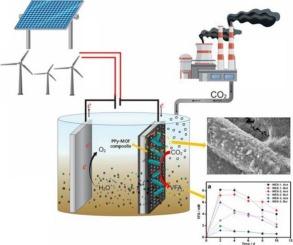Accelerating CO₂ conversion to volatile fatty acids using metal-organic framework–biocathode interfaces in microbial electrosynthesis
Q1 Environmental Science
引用次数: 0
Abstract
This study presents the development of an innovative biocathode using amine-functionalized bimetallic metal-organic framework (NH₂-UiO-66 Zr/Fe) coated on polypyrrole‑carbon cloth (PPy-MOF/CC) for enhanced microbial electrosynthesis (MES). The engineered electrode exhibited improved electrochemical performance under both abiotic and biotic conditions. When used in MES, the PPy-MOF/CC cathode achieved the highest average current density of 2.17 A/m2 among all tested systems, supporting efficient conversion of carbon dioxide (CO₂) into acetate and isobutyrate with an equivalent chemical oxygen demand (COD) yield of 0.72 gCOD/L·d. This yield is higher compared to MES using PPy/CC and bare CC, which had average COD yields of 0.33 and 0.11 gCOD/L·d, respectively. The MES also achieved notable Coulombic efficiency (87 %) and carbon conversion efficiency (81 %). Cyclic voltammetry confirmed the superior bioelectrochemical activity of the PPy-MOF/CC cathode relative to the control biocathodes. These findings demonstrate the effectiveness of PPy-MOF/CC as a biocathode material for improving CO₂-to-VFA conversion in MES.

在微生物电合成中使用金属-有机框架-生物阴极界面加速CO₂转化为挥发性脂肪酸
本研究提出了一种创新的生物阴极,利用胺功能化的双金属金属有机骨架(nh2 -UiO-66 Zr/Fe)涂覆在聚吡咯-碳布(py - mof /CC)上,用于增强微生物电合成(MES)。该电极在生物和非生物条件下均表现出较好的电化学性能。应用于MES时,PPy-MOF/CC阴极在所有测试系统中平均电流密度最高,为2.17 A/m2,支持二氧化碳(CO 2)高效转化为乙酸和异丁酸盐,当量化学需氧量(COD)产率为0.72 gCOD/L·d。该产率高于使用PPy/CC和裸CC的MES,后者的平均COD产率分别为0.33和0.11 gCOD/L·d。MES还取得了显著的库仑效率(87%)和碳转化效率(81%)。循环伏安法证实了PPy-MOF/CC阴极相对于对照生物阴极具有更好的生物电化学活性。这些发现证明了py - mof /CC作为生物正极材料在MES中提高CO 2到vfa转化的有效性。
本文章由计算机程序翻译,如有差异,请以英文原文为准。
求助全文
约1分钟内获得全文
求助全文
来源期刊

Bioresource Technology Reports
Environmental Science-Environmental Engineering
CiteScore
7.20
自引率
0.00%
发文量
390
审稿时长
28 days
 求助内容:
求助内容: 应助结果提醒方式:
应助结果提醒方式:


